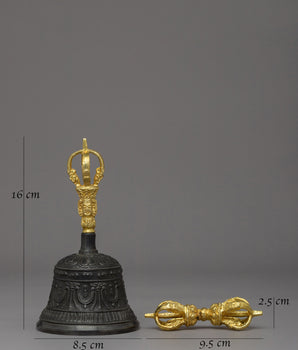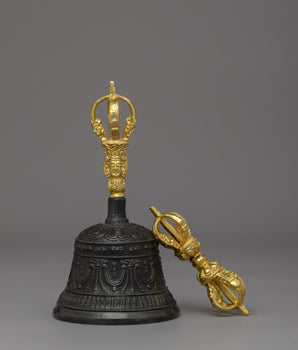Ratnasambhava, Rin Chen Jung Den (Tib.), holds an important place among the five Tathagatas, the Dhyani Buddhas, or the five Meditation Buddhas, alongside Akshobhya, Vairocana, Amitābha, and Amoghasiddhi. Each of these enlightened beings represents distinct aspects of enlightenment. Ratnasambhava, as the embodiment of the Jewel Family, symbolizes the transformative qualities of equanimity (Skt. Samatajnana), generosity, and abundance. The very name "Ratnasambhava" signifies his innate ability to manifest and bestow precious treasures upon the world.

Find excellent Statue sets of the Five Dhyani Buddhas
Exploring Ratnasambhava's Origins
The earliest documented references to Ratnasambhava can be traced back to the Suvarṇaprabhāsa Sūtra and the Guhyasamāja Tantra, both dating from the 4th century CE. However, it is within the Pañcakara section of the Advayavajrasaṃgraha that we find more detailed accounts of Ratnasambhava. This sacred text provides deeper insights into his nature and role within the Buddhist pantheon.
- Ratnasambhava in the Śūraṅgama Mantra and Sutra
The Śūraṅgama mantra, a highly influential dharani within the Chinese Buddhist tradition, as taught in the Śūraṅgama sutra, mentions Ratnasambhava as the host of the Jewel-creating Division in the South. This division holds a crucial responsibility, commanding vast demon armies from five directions. It is through this portrayal that Ratnasambhava showcases his power to transmute negativity and bring about positive transformation.
- Ratnasambhava's Presence in Vajrayana Texts
Ratnasambhava continues to make appearances in numerous Vajrayana texts, solidifying his significance within this tradition. His association with jewels resonates as a literal representation and a metaphor for the inherent qualities of wisdom and compassion that lead to abundance and spiritual richness.
- The Kṣitigarbha Bodhisattva Pūrvapraṇidhāna Sūtra and Ratnasambhava
Chapter 9 of the Kṣitigarbha Bodhisattva Pūrvapraṇidhāna Sūtra pays homage to Ratnasambhava as one of the revered Buddhas. This sacred scripture recognizes his enlightened qualities and praises his role in guiding sentient beings toward liberation.
Delving into the Symbolism of Ratnasambhava Buddha
Ratnasambhava Buddha, the compassionate embodiment of giving, extends his blessings impartially to all beings, transcending societal roles, races, genders, and forms of life. His teachings emphasize the recognition of the inherent worth and preciousness of every being, fostering compassion and unity among all sentient creatures.
Central to Ratnasambhava's teachings is the symbolism of the mandala, a visual representation of the enlightened mind. Let us explore the intricate details of Ratnasambhava's mandala and uncover its structure and significance.
- The Jewel: Symbolizing Intrinsic Value
The jewel holds a central position in Ratnasambhava's symbolism, representing the innate value and preciousness of all beings. Just as a jewel is polished to reveal its inherent beauty, Ratnasambhava's teachings guide us to recognize and nurture the intrinsic richness and potential within ourselves and others.
- Abundance: Embracing Plenitude
Ratnasambhava's domain is associated with abundance in its various manifestations, including material wealth, spiritual richness, and emotional well-being. By connecting with Ratnasambhava's energy, we can cultivate a mindset of abundance, fostering gratitude and generosity in sharing resources with others.
- Equanimity: Embracing Balance
Ratnasambhava embodies equanimity, the state of maintaining composure and balance amidst the ever-changing circumstances of life. This quality encourages practitioners to embrace all experiences with acceptance, recognizing the interconnectedness and impermanence of all phenomena.
- Mandala: Guiding the Path to Awakening
The mandala serves as a sacred blueprint, guiding practitioners on their journey toward awakening and self-realization. In Ratnasambhava's mandala, the intricate arrangement of symbols and deities represents the interconnectedness of all aspects of existence. By meditating on the mandala, we gain insight into the nature of reality and our place within it.
- Contemplating Ratnasambhava: Cultivating Compassion
By contemplating Ratnasambhava, we cultivate compassion and extend it to all beings. His teachings inspire us to recognize the intrinsic worth of every individual and to embrace unity beyond societal divisions. Through this practice, we foster solidarity and extend our compassion to encompass all forms of life.
Recognizing Ratnasambhava: Ratnasambhava Iconography
The Buddha of Peaceful Appearance, Ratnasambhava, is depicted in various iconographies that symbolize his serene and compassionate nature. He is often portrayed in two distinct appearances: the 'Bodhisattva appearance' and the 'Buddha appearance.' Let us explore the different aspects of Ratnasambhava's iconography.
Bodhisattva Appearance and Buddha Appearance
In the Bodhisattva appearance, Ratnasambhava radiates tranquility and serenity. This depiction emphasizes his role as a Compassionate Bodhisattva who selflessly works for the benefit of all sentient beings. On the other hand, the Buddha's appearance portrays Ratnasambhava as an enlightened being, exuding wisdom and serenity.
- Radiant Yellow Color and Golden Complexion
Ratnasambhava is often depicted in a vibrant yellow color, which symbolizes the richness of the earth and represents his transformative qualities. This yellow hue signifies abundance, generosity, and spiritual richness. However, some variations of Ratnasambhava's iconography may present him with a golden complexion, further emphasizing his radiant and enlightened nature.
- Varada Mudra: Gesture of Generosity

Buy Gold Gilded Buddhist Statues of Ratnsambhava and many more.
In his right hand, Ratnasambhava extends the Varada mudra, also known as the gesture of generosity. This mudra symbolizes his selfless nature and his willingness to offer assistance and support to all sentient beings. It signifies Ratnasambhava's boundless compassion and his role as a bestower of blessings and abundance.
- Magnificent Throne Supported by Horses
In many depictions, Ratnasambhava is seated on a magnificent throne that is often supported by horses. This imagery represents his noble qualities, symbolizing his regal presence and divine attributes. The horses beneath the throne symbolize his swift ability to respond to the needs of sentient beings and to bring about positive transformation.
- Symbolism of Peace, Abundance, and Benevolence
Ratnasambhava's iconography embodies the qualities of peace, abundance, and benevolence. His serene appearance and radiant colors inspire a sense of tranquility and harmony. The Varada mudra reflects his compassionate and generous nature, reminding practitioners of the importance of selflessness and extending kindness to others. The depiction of a majestic throne supported by horses represents his noble and regal qualities, symbolizing his ability to bring blessings and abundance into the world.
Ratnasambhava's iconography captures the essence of his compassionate and benevolent nature. His depictions in the Bodhisattva appearance and Buddha appearance, along with the vibrant yellow color or golden complexion, signify his transformative qualities. The Varada mudra and the magnificent throne supported by horses symbolize his generosity, regality, and ability to bring about positive change. Ratnasambhava's iconography serves as a visual reminder to practitioners to cultivate peace, abundance, and benevolence within themselves and extend these qualities to all sentient beings.















